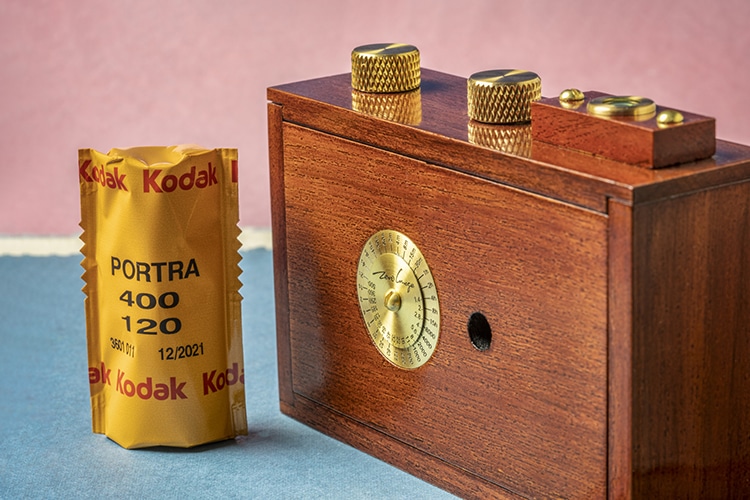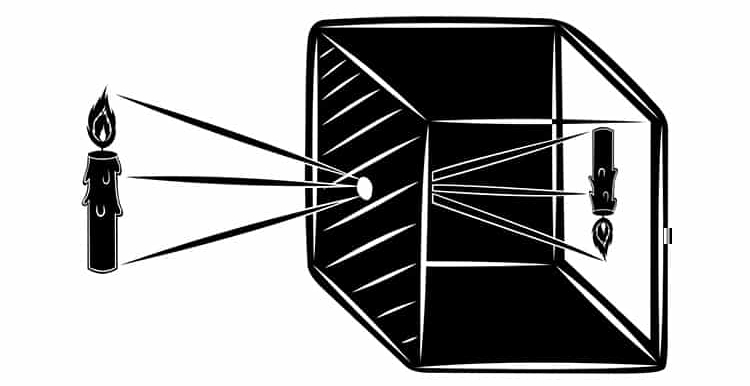
A pinhole camera and medium format film. (Photo: PIXELSAWAY/Depositphotos)
This post may contain affiliate links. If you make a purchase, My Modern Met may earn an affiliate commission. Please read our disclosure for more info.
Today’s DSLR cameras and smartphones may seem complicated, but there is still a charm to old-fashioned photography techniques. Since its invention, photography has utilized the simple physical properties of the camera obscura effect. A pinhole camera—simply a box or camera body with a very small hole as a lens—is the perfect way to pare photography down to these essentials.
Pinhole cameras can produce images with dramatic vignettes, motion blurs, and gently warped perspectives. Read on to learn more about pinhole photography and how to get started creating your own unique artwork.
Understanding the Camera Obscura Effect and Pinhole Camera

The camera obscura effect. (Photo: 2DMARI/Depositphotos)
Like our eyes, cameras register light. Light travels in straight rays from the object producing or reflecting it. In the 5th century BCE, the Chinese philosopher Mozi (470 – 390 BCE) first documented the curious effect of camera obscura (Latin for “darkroom”). As light traveled through a small hole into a dark space, the outside image appeared flipped and inverted. By the Renaissance, the effect was readily used for both amusement and as an artistic guide for drawing perspective.
The camera obscura was a useful tool in the 19th century. A small hole in a dark room could project a large image on a wall. Portable camera obscuras were crafted from wood, and either a pinhole or a lens allowed the light in. This opening is known as an aperture. Additionally, mirrors were often added at the backside of the box, which could reflect the image upwards to be viewed on glass. Artists could trace the image on top of the glass. When photo-sensitive materials were developed in the 19th century, they were combined with the camera obscura effect to create photography as we know it. The classic Brownie box camera of the early 20th century was a (usually) lens-less, dark box that added a shutter and film to the classic camera obscure.
Today’s pinhole cameras take a variety of shapes. You can build your own, buy a specially-crafted film camera with a tiny aperture, or purchase affordable specialized lenses for both film and digital camera bodies.
Pinhole cameras are a great opportunity for scientific and artistic inquiry. People have turned trash cans and soda cans into pinhole cameras. One beer can stuck to the side of an observatory in the UK captured the longest exposure ever. The light-sensitive paper inside showed eight years’ worth of solar paths across the sky.
Getting Started With Film
View this post on Instagram
Film is the perfect medium for pinhole photography. The sharp quality and elegant contrast of black and white film produces stunning images. However, almost any type of film can be used, and it is worth experimenting with Kodak, Ilford, and Lomography stocks. Direct positive photographic paper can also be used and is particularly well-suited to larger format cameras. You can find—or make—a pinhole camera for any size of film or paper, but many photographers choose to use 120 mm film for the wide variety of camera options available.
For 35mm film, you can build your own camera using a matchbox, used film cartridge, aluminum can, and a lot of tape. If this seems like too much crafting, you can purchase a lens for your classic SLR. Thingyfy makes pinhole lenses (both fixed focus and zoom) for almost all camera lens mounts—simply pop them on your camera and get to shooting.
More pinhole-specific cameras can be found for medium format, also known as 120 mm, film. The classic plastic toy camera Diana F+ can be used as a pinhole camera. You can also get experimental with the Holga panoramic pinhole toy camera. For stunningly crafted wood pinhole cameras you will love to show off, check out the Vermeer 6×9 Deluxe and the Ondu 6×6, which can even hold lens filters over the pinhole.
View this post on Instagram
If large format is your passion, pinhole is the perfect creative next step. Both Ondu and Vermeer make sleek wooden cameras compatible with standard 4×5 film holders. If you find they are a bit pricey for a pinhole photographer just starting out, you can easily craft your own camera out of a simple cardboard box with these instructions from PetaPixel. You will need to load the photographic paper in the dark, like film. Direct positive paper will produce a ready-to-go image when developed. Regular “printing” paper will produce a paper negative, which is easy to invert digitally when scanned.
View this post on Instagram
Last but not least, the small aperture used in pinhole photography requires a long exposure, sometimes many minutes depending on the film. To measure the required exposure, use a metering app that allows for very small apertures or search around online for guides to the particular film. You will have to account for reciprocity failure—film loses light sensitivity at longer exposure times. Thankfully, part of the fun of pinhole photography is experimentation, and the long exposures allow for leeway. Always remember to use a tripod or place your camera on a sturdy surface so your image is not blurred.
Getting Started With Digital
View this post on Instagram
Already have a DSLR camera? Pinhole photography is not just for film. Thingfy‘s lenses fit most of today’s cameras, and unlike with film, your results are viewable on the spot. Keep in mind your lens mount and sensor size, as well as if you would like a shorter focal length for a wider field of view. You can also take a body cap and make your own pinhole lens.
Pinhole fun can still be had without a DSLR. Ashley Hackshaw of Little Blue Boo has the perfect simple hack to turn your phone camera into a pinhole lens. You only need a needle, cardboard, and tape to start taking your own digital pinhole images. The magic—as with film—is in the experimentation. What will you photograph today to start your pinhole journey?
View this post on Instagram
Related Articles:
How the Development of the Camera Changed Our World
Crafty Pop-Up Book Opens Up Into a Functional Pinhole Camera
Get an “Instant” History of How Polaroid Revolutionized Photography
Learn How the Affordable Kodak Brownie Camera Made Photography Accessible
